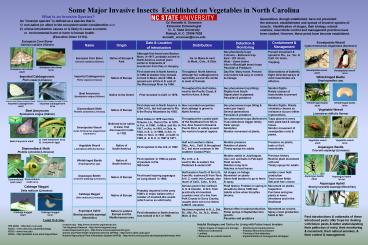Home Vegetable Pest Management PowerPoint PPT Presentation
Title: Home Vegetable Pest Management
1
Some Major Invasive Insects Established on
Vegetables in North Carolina
- What is an Invasive Species?
- An "invasive species" is defined as a species
that is - non-native (or alien) to the ecosystem under
consideration and - whose introduction causes or is likely to cause
economic or environmental harm or harm to
human health.
(Executive Order 13112).
Quarantines, though established, have not
prevented the entrance, establishment and spread
of invasive species of insects. Identification
of stages, their biology, natural enemies,
insecticide control and management practices have
been studied. However, these pests have become
established.
Dr. Kenneth A. Sorensen Extension Entomologist N
. C. State University Raleigh, N. C.
27695-7626 kenneth_sorensen_at_ncsu.edu
Name Origin Date Location of Introduction Distribution Detection Monitoring Containment Management
European Corn Borer Ostrinia nubilalis (Hübner) Native of Europe Asia Although first found near Boston, Mass. in 1917, probably arrived in North America several years earlier in shipments of broomcorn from Italy or Hungary. Ga. to Maine west to Mont., Colo., Okla. Sex pheromone traps2 strains Bollworm trapEast - (NY strain)West (Iowa strain)Also in Blacklight insect trapsParasites Predators Prevent movement spread to Fla., La., Tex. Calif. On hosts. Trapping
Imported Cabbageworm Pieris rapae (Linnaeus) Native of Europe First observed in North America in 1860 at Quebec City, Canada. Arrived in Mass. about 1869, spread over all the U.S. east of the Mississippi River by 1886. Throughout North America although few cabbageworms reportedly survive the winter in most of Canada Day flier. Many hosts. Present everywhere but easy to control manage. Observations of butterfly flight. Directed sprays of most insecticides are effective.
Beet ArmywormSpodoptera exigua (Hübner) Native to the Orient First recorded in Calif. in 1876. Throughout the Gulf states, west to the Pacific Coast, north to Kans. Nebr. Sex pheromone trap (Wing)Flights from SouthSignal plant is pigweed.Parasites predators Monitor flights.Rotate classes of insecticides to prevent resistance.
Diamondback Moth Plutella xylostella (Linnaeus) Native of Europe First observed in North America in 1854, in Ill., but had spread to Fla. the Rocky Mountains by 1883. Now recorded everywhere that cabbage is grown in North America Sex pheromone traps (Wing water pan traps)Several generationsParasites predators Monitor flights. Rotatechemistry classes as resistance occurs within 3 generations.
Sweetpotato Weevil Cylas formicarius elegantulus (Summers) Believed to be native to Asia first discovered in India in 1792 West Indies in 1875 near New Orleans, LA., then in Fla. in 1878, in Tex. in 1890, in Miss. and Ga. in 1917, in Ala. in 1918, in Okla. in 1922, in S. C. in 1966, in Ark. in 1982, in Tenn. in 1983 , in Calif. in 1993, in N. C. in 1967 1971. Throughout the coastal plain of the Southeast from NC to Tex. Also found in Hawaii Puerto Rico, widely around the world in tropical regions. Sex pheromone traps (Bollweevil)Trap collections trigger timely foliar sprays SanitationMonitor movement of plants. Traps placed in every field, plant bed storage house. Monitor movement of sweetpotato roots plants.
Vegetable Weevil Listroderes difficilis Germar Native of South America First reported in the U.S. in 1922 Gulf and southern states, Okla., Ariz., Calif. throughout N.C. but more common in the southern Coastal Plain Monitor presenceRotation of plantsTimely sprays for adults Presence on plants, buds or fruit.Insecticides
Whitefringed BeetleGraphognathus spp. Native of South America First reported in 1936 as pests of peanuts in Fla. 385 hosts Fla. to N. J. west to Mo. eastern Tex.Piedmont eastern NC Monitor adults in July/August.Use corn soil baits in Feb-AprilField recordsRotation long termNotches in host leaves Previous historyRestrict plant movement with soilTimely sprays for adults
Asparagus BeetleCrioceris asparagi (Linnaeus) Native of Europe First found injuring asparagus on Long Island in 1860. Northeastern fourth of the U.S., from Mo. eastward from Tenn. N. C. north into Canada also much of Calif., Colo., Ore. All stages on foliageMovement on plantsAllow field borders to go to ferns spray Isolate crown field productionTreat crown fieldsSell pest free crowns
Cabbage Maggot Delia radicum (Linnaeus) Native of Europe Probably imported in the early 1800's in ships' ballast with a number of mustard-like weeds (which serve as wild hosts) Serious pest in the northern U. S. Canada. In N.C. from practically all mountain counties west of a line from Polk County to Surry County usually does not occur below 3,000 ft. elevation. Field history. Problem in spring in elevations above 1000 feet.Adults active when forsythia blooms. Movement on plants.InspectionPurchase and grow plants in lower elevations and in the Southeast
Asparagus Aphid Brachycorynella asparagi (Mordvilko) Native to eastern Europe and the Mediterranean area First infestation in North America was noticed in N.Y. in 1969. Has been reported in N. J., Del., R.I., Md., Pa., Va., N.C., Wash., Mich. Ore. Bonsai effect in plant production.Foliar sprays in September fern growth.Parasites and predators Movement on crowns.Spray crown production fields in fall.
Past introductions outbreaks of these
introduced pests offer hope for dealing with
future pests better understanding their
pathways of entry, their monitoring movement,
their natural enemies, their control
management.
Useful Web Sites
Helpful Strategies and Tactics for Living with
Future Insect Invaders
Invasive.org - http//www.invasive.org/insects.cfm
The Bugwood Network - http//www.bugwood.org/ Inv
asivespeciesinfo.gov - http//www.invasivespeciesi
nfo.gov/ Animal and Plant Health inspection
Service (APHIS) - http//www.aphis.usda.gov/ Natio
nal Agricultural Pest Information System (NAPIS)
- http//www.ceris.purdue.edu/napis/pests/insects.
html
IPM NCSU - http//ipm.ncsu.edu NCSU -
www.cals.ncsu.edu/entomology NCSU -
www.ncsu.edu NCSU - http//pestdata.ncsu.edu/crop
profiles/

